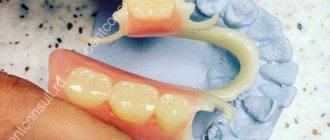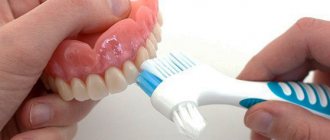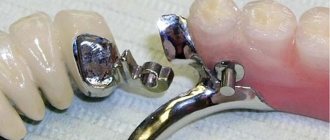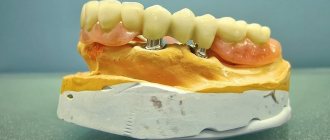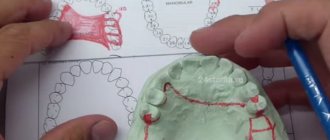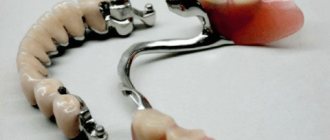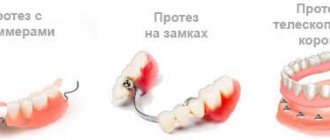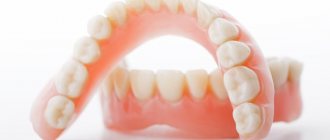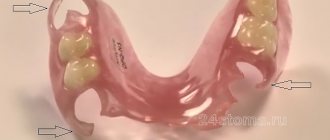Dentistry, as one of the most advanced branches of medicine, is constantly introducing new technologies. Today, dental offices offer a variety of prosthetic methods for tooth loss. However, some of them, such as implants, require large financial costs and are not suitable for everyone due to health reasons. An alternative solution could be a denture clasp denture.
What is a clasp prosthesis?
Precision casting technologies, which have become widely used in dentistry, have made it possible to introduce into practice the installation of removable clasp (yoke) dentures. The clasp is a frame made of plastic or metal, consisting of two basic parts - left and right. Both parts of the prosthesis, on which the artificial teeth are located, are connected to each other by a special arch. The load of the structure is distributed between the gums and supporting teeth. The size of the dentures depends on the shape of the jaw, the number of defects in the dentition, and the condition of the oral mucosa.
There are several options for fixing the clasp to the supporting teeth:
- using clasps (hooks);
- through micro-locks (attachments);
- using telescopic crowns;
- using beam overlays.
Depending on the condition of the jaw, several methods can be used simultaneously to attach the prosthesis, for example, using clasps and attachments.
Manufacturing stages and installation
Prosthetics with clasp dentures with clasps includes two main stages - clinical and laboratory. From the moment you contact the clinic until the restoration of the dentition, the following stages occur:
- Examination. The doctor draws up a prosthetic plan, makes a conclusion about the state of oral health and, if necessary, sends the patient for treatment of caries and/or periodontal disease.
- Taking an impression of both jaws.
- Making a prosthesis in the laboratory. Structures with metal elements are made by casting methods, while plastic ones are produced under exposure to high temperatures.
- Trying on the finished design. If necessary, correction is carried out.
- Installation of the prosthesis.
On average, the clinical and laboratory stages of prosthetics take one week.
Splinting clasp prosthesis
To strengthen loose teeth due to periodontal diseases, a splinting clasp prosthesis is used. This is a removable block consisting of linings and retainers, which limits the mobility of the dentition. The arch adjacent to the inner surface of the gums is equipped with clasps that strengthen each tooth.
To use a clasp, you must have at least 6 supporting teeth on one and the other jaw. The supporting teeth themselves must be stable and able to withstand the chewing load. Installing a splinting prosthesis helps solve two problems at once - restore lost teeth and strengthen loose ones.
How to care for a prosthesis?
Clasp dentures with clasps should be cleaned at least twice a day, or better yet, after each meal. Hygienic measures include:
- rinsing the structure under running water after eating;
- daily disinfection (soaking in solutions of disinfectant tablets Corega, Lacalut, Efferdent, President, Dentipur, Dontodent, etc.);
- professional cleaning (performed by a dentist to remove hard deposits).
cleaning with a brush and low-abrasive paste at least twice a day;
To maintain the original appearance of the prosthesis, you should not abuse smoking, coffee and tea, which cause artificial teeth to change color and become covered with plaque.
It is advisable not to remove the prosthesis at night and to remain in it constantly. Once every six months you need to visit the dentist to reline the structure (correction to evenly distribute the chewing load).
The result of prosthetics depends not only on the quality of the prosthesis, but also on the qualifications and skill of the orthopedic dentist. Our website provides an up-to-date list of clinics that effectively restore dentition using clasp structures.
Production of clasp dentures on a fire-resistant model
The complex structure, which is the clasp denture, is made by dental technicians. To obtain an accurate frame, modeling and casting from special wax is carried out on a fireproof model. It is made on the basis of a conventional plaster model.
An induction casting machine is used to cast a metal clasp blank. Acrylic teeth are then placed on the wax model. The technician sends a mock-up of the prosthesis to the patient to try on. The dentist carefully checks the clasp in all respects: the accuracy of the prosthesis fit on the gum, the quality of the bite, the tightness of the fit to the teeth. After correcting the deficiencies identified by the dentist, the technician replaces the wax base with a plastic one.
There are differences in technologies for the production of clasps with other types of fastenings, for example, with telescopic crowns, but they are not very radical.
In the manufacture of some types of prostheses, such as Quadrotti, the base of the clasp is made not of metal, but of plastic.
Advantages of our clinic
- Superior safety standards. There is no place for HIV and hepatitis in our dental clinic! We work according to international safety standards.
- Dental treatment without pain. The most modern gentle painkillers are used for treatment. Even if a person has allergies, we will make the treatment procedure painless.
- We have smart doctors. Specialists constantly improve their knowledge.
- We use cutting-edge medical equipment and technology.
- Children's dentistry. We care about your children, we can find an approach to even the most capricious baby.
- Dentistry at fair prices.
Our dentistry is the territory of a smile, don’t hide your teeth! We offer a full range of modern dental services, regardless of the category of the population: children, adults, students, pensioners, disabled people.
In our dental clinic, patients can be offered not only a wide range of therapeutic and aesthetic services, but also a large selection of surgical procedures. They are performed by highly qualified dental surgeons.
A smile makes a person not only beautiful, but also very charming. We will do everything possible and impossible to ensure that your smile regains its former beauty, naturalness, and perfection.
Options for fixing clasp dentures
To install the clasp, several types of clamps are used:
- clasps. Special hooks hold the prosthesis on the supporting teeth. The disadvantages of this type of fastening include low aesthetics, since the hooks are noticeable when you smile. However, sometimes clasps are simply necessary, for example, when splinting, each tooth must be fixed;
- micro locks One part of the attachment is located on the clasp, and the other is under the crown on the supporting tooth, so the lock is securely fixed and is not noticeable in the oral cavity. This is one of the best technologies for fixing a prosthesis;
- beam overlays. This type of fastening is used when there is a large distance between the supporting teeth. The abutment teeth, covered with crowns, are connected by metal beams, which snap onto counter-beams inserted into an acrylic base. The onlays are not visible on the teeth;
- telescopic crowns. The clasp is fixed to metal crowns installed on the supporting teeth. Ceramic crowns are made on the prosthesis and placed on metal ones. The design must be made very accurately, so a parallelometer is used to make it. The fixation is reliable, and the service life of the prosthesis is the longest.
After a thorough examination, the dentist selects the desired fixation option.
Advantages and disadvantages
Advantages:
- strength (structures with a metal arc are much stronger than plate ones);
- durability (they last up to 10 years, and plate ones need to be changed every 2-3 years);
- no need to grind the supporting teeth (unlike a bridge, which is fixed only to the processed teeth);
- ease of wearing (due to the thin and non-volume base);
- relatively low cost (cheaper than implants and ceramic bridges);
- assistance in the treatment of periodontal disease (splinting structures hold teeth with pathological mobility).
Minuses:
- low aesthetics (clasps are visible when you smile);
- long addiction (due to the base on the sky, addiction takes a couple of weeks);
- the pressure of the clasps on the tooth enamel (with strong chewing loads, the enamel can be damaged).
To avoid these disadvantages, many choose clasp dentures with locks.
Indications for installation
Clasp dentures on hooks are used in the following cases:
- in the absence of several teeth in a row;
- included defects (loss in different places of the jaw);
- end defects (no outer teeth);
- periodontal diseases and tooth mobility from this. The arc prosthesis splints and keeps them stationary;
- increased wear of crowns. The denture covers them, protecting them from further abrasion.
Many patients choose an arched prosthesis because they want to move away from the insufficiently comfortable plate one.
What dentures are the best and most comfortable?
Each prosthetic structure has specific characteristics that determine its scope of application.
For upper teeth
The incisors and canines experience less stress compared to the chewing teeth, and they are also within sight. For their prosthetics, the optimal types of fixed prostheses are crowns, adhesive bridges made of zirconium dioxide, glass-ceramics, and metal-ceramics. Molars and premolars are practically invisible, so it is advisable to install durable, inexpensive metal or combined dentures instead. For minor defects, veneers and lumineers are placed in front, and inlays are placed in the back.
Crowns on front teeth
For the bottom
The lower front teeth, like the upper ones, are also located in the smile zone, so fixed structures for them should be as aesthetic as possible. You can save a little on unobtrusive chewing dental units, so the recommendations are the same as in the previous paragraph.
With partial absence of teeth
In such cases, single defects are corrected with cantilever or adhesive bridges. You can also install immediate dentures during a two-stage implantation process. Severe edentia requires the installation of high-quality clasp dentures; you can also try a removable sandwich.
With complete edentia
Most often, inexpensive plate structures are used, but they deform the gums, do not hold well, and cause discomfort. The optimal solution in this case is complete dental implantation.
For temporary prosthetics
In such cases, immediate prostheses are usually used. Cantilever structures can also be used as non-permanent ones.
For children
Which dental prosthetics will be best for a child depends on the specific situation. Typically, children need butterfly dentures during the period of changing teeth to correct the dentition.
| Problem | Suitable prosthesis | Min. price, rub. |
| Upper and lower jaw: Minor, single defects of the anterior and posterior teeth | Ceramic veneers, lumineers | 8000-30000 |
| Zirconium crowns, 1 pc. | 30000 | |
| Metal-ceramic crowns, 1 pc. | 10000 | |
| Metal crowns, 1 pc. | 5000 | |
| Metal-ceramic bridge, 3 units. | 36000 | |
| Glass-ceramic bridge, 3 units. | 72000 | |
| Partial edentia | Adhesive bridge | 13000 |
| Cantilever bridge | 18000 | |
| Clasp prosthesis | 35000 | |
| Completely edentulous | All-on-4 | 400000 |
| All-on-6 | 500000 | |
| Temporary prosthesis | Metal-ceramic crown | 10000 |
| Changing teeth in children | Immediate prosthesis | 3000 |
Reviews about prosthetics with clasp structures
If you are interested in the question of which structures are best to install, clasp dentures have already earned the most positive reviews. This is due, first of all, to the presence of a metal base, which ensures optimal dimensions of the structure and achieves maximum comfort during its operation, as well as when communicating and chewing food.
- Convenience during wearing : when such an orthopedic product is put on the lower jaw, the necessary space remains for the movement of the tongue, reduces the likelihood of changes in diction and minimizes the risk of sudden loss of the structure from the oral cavity. This is facilitated, first of all, by the presence of a small plastic base. In the case of restoration of the upper units with a nylon or plastic analogue, the entire sky is covered with the base of the structure. If a clasp prosthesis is fixed on the upper jaw, then the frontal part of the palate, which is responsible for taste sensations and normal spoken speech, remains free;
- Long service life : the service life of the clasps can reach 5-7 years compared to their removable plastic counterparts, which require mandatory replacement every 2 years. This is due to the rapid rate of loss of bone under a conventional prosthesis, which is accompanied by discomfort during wear and weakening of fixation;
- Increased reliability indicators : the probability of the clasp breaking is quite low, since it includes a solid base made of high-strength metal.
Expert opinion
Roman Borisovich Alekperov
orthopedic dentist
Experience: 24 years
Advantages of clasps over attachments. When there is a need to restore the dentition, and the dental defects are scattered, the patient does not have enough financial resources, I recommend installing clasp dentures with clasps. You quickly get used to them, their production does not require much time, the chewing load is distributed on the teeth, and not on the gums, as is the case with lamellar ones. Yes, the aesthetics are insufficient because of the visible hooks, but you have teeth, you can eat, drink, and live a normal life.
